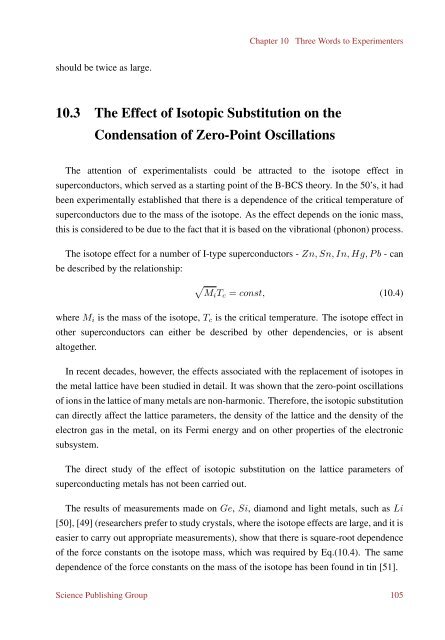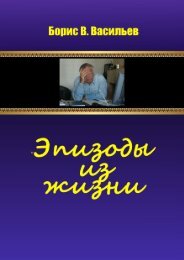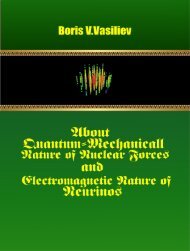978-1-940366-36-4_WholeBook
Boris V. Vasiliev Supercondustivity Superfluidity
Boris V. Vasiliev
Supercondustivity Superfluidity
You also want an ePaper? Increase the reach of your titles
YUMPU automatically turns print PDFs into web optimized ePapers that Google loves.
Chapter 10<br />
Three Words to Experimenters<br />
should be twice as large.<br />
10.3 The Effect of Isotopic Substitution on the<br />
Condensation of Zero-Point Oscillations<br />
The attention of experimentalists could be attracted to the isotope effect in<br />
superconductors, which served as a starting point of the B-BCS theory. In the 50’s, it had<br />
been experimentally established that there is a dependence of the critical temperature of<br />
superconductors due to the mass of the isotope. As the effect depends on the ionic mass,<br />
this is considered to be due to the fact that it is based on the vibrational (phonon) process.<br />
The isotope effect for a number of I-type superconductors - Zn, Sn, In, Hg, P b - can<br />
be described by the relationship:<br />
√<br />
Mi T c = const, (10.4)<br />
where M i is the mass of the isotope, T c is the critical temperature. The isotope effect in<br />
other superconductors can either be described by other dependencies, or is absent<br />
altogether.<br />
In recent decades, however, the effects associated with the replacement of isotopes in<br />
the metal lattice have been studied in detail. It was shown that the zero-point oscillations<br />
of ions in the lattice of many metals are non-harmonic. Therefore, the isotopic substitution<br />
can directly affect the lattice parameters, the density of the lattice and the density of the<br />
electron gas in the metal, on its Fermi energy and on other properties of the electronic<br />
subsystem.<br />
The direct study of the effect of isotopic substitution on the lattice parameters of<br />
superconducting metals has not been carried out.<br />
The results of measurements made on Ge, Si, diamond and light metals, such as Li<br />
[50], [49] (researchers prefer to study crystals, where the isotope effects are large, and it is<br />
easier to carry out appropriate measurements), show that there is square-root dependence<br />
of the force constants on the isotope mass, which was required by Eq.(10.4). The same<br />
dependence of the force constants on the mass of the isotope has been found in tin [51].<br />
Science Publishing Group 105













